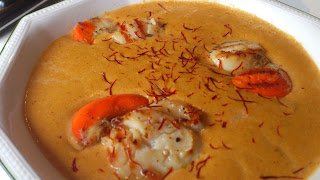I was asked the other day ‘What is the difference between a soup and a broth?’ Good question. Simple, surely a broth is a thin, unenhanced soup, isnt’t it? But then what is the difference between a stock and a broth? Or a stew? Or a bisque? Even a Chowder, Consomme or a Puree?
A soup is typically a combination of vegetables or meats cooked in liquid. They are made up of a
thin water, juice or milk based broth. They are considered a starter not a main
course. They can be cooked or uncooked and served hot or cold. Soups are cooked at high temperatures and
rely on herbs, spices and garnishes to create their deep flavours.
Bisque
 Bisque is a thick, creamy soup. It is traditionally made from pureed shell fish. All parts of the shell fish are used, even the shells, and ground into a thick paste and added back to the bisque.
Bisque is a thick, creamy soup. It is traditionally made from pureed shell fish. All parts of the shell fish are used, even the shells, and ground into a thick paste and added back to the bisque.
Chowder
A Chowder is a soup that is thickened with flour. Often its is seafood based such as clam chowder, but can consist of vegetables.
Broth
 A broth is an un-thickened liquid food in which meat,
fish, grains or vegetables have been simmered, and is eaten as a finished dish. It is often the starting point for other
liquids such as soups or gravies. Broths differ from stocks in that they are
made from finer foods and are richer and more nourishing than a stock.
A broth is an un-thickened liquid food in which meat,
fish, grains or vegetables have been simmered, and is eaten as a finished dish. It is often the starting point for other
liquids such as soups or gravies. Broths differ from stocks in that they are
made from finer foods and are richer and more nourishing than a stock.
Stews
 Stews are thicker than soups. They are often thickened with potatoes and are served hot. Ingredients in a stew are chunkier than a soup, and the liquid in a stew is more of a gravy than a broth. Stews are cooked over a low heat for a long time. Generally stews contain less liquid than soups.
Stews are thicker than soups. They are often thickened with potatoes and are served hot. Ingredients in a stew are chunkier than a soup, and the liquid in a stew is more of a gravy than a broth. Stews are cooked over a low heat for a long time. Generally stews contain less liquid than soups.
Consomme
A consommé is a broth that has been adapted. Often egg whites are added to the broth and simmered gently to coagulate the sediment, which rises to the top. This sediment is skimmed off the surface and a clear, pale liquid remains.
Puree
A purée is a food that has been mashed, pressed and strained into a soft paste. They are often made up from vegetables of fruit. They can resemble soups or gravies but are separated merely a less complex cooking process and by the lack of additional ingredients.
A purée is a food that has been mashed, pressed and strained into a soft paste. They are often made up from vegetables of fruit. They can resemble soups or gravies but are separated merely a less complex cooking process and by the lack of additional ingredients.
For related articles click onto:
Is the sea sponge a plant or an animal?
What is a broccoflower?
What is a loofah?
What is a sea cucumber?
The worlds largest vegetable
The anatomy of vegetables
What is the difference between a chicken and a hen?
What is the difference between a currant, raisin and a sultana?
What is a broccoflower?
What is a loofah?
What is a sea cucumber?
The worlds largest vegetable
The anatomy of vegetables
What is the difference between a chicken and a hen?
What is the difference between a currant, raisin and a sultana?
What is the difference between a marrow and a courgette?
What is the difference between butter and margarine?
What is the difference between a butterfly and a moth?
What is the difference between butter and margarine?
What is the difference between a butterfly and a moth?
What is the difference between a rambling and climbing rose?
What is the difference between a peach and a nectarine?
What is the difference between a rhododendron and an azalea?
What is the difference between a turnip and a swede?
What is the difference between a soup and a broth?
What is the difference between a stew and a casserole?
What is the difference between a yam and a sweet potato?
What is the difference between a vegetable and a fruit?
What is the difference between gammon, ham and bacon?
What is the difference between a peach and a nectarine?
What is the difference between a rhododendron and an azalea?
What is the difference between a turnip and a swede?
What is the difference between a soup and a broth?
What is the difference between a stew and a casserole?
What is the difference between a yam and a sweet potato?
What is the difference between a vegetable and a fruit?
What is the difference between gammon, ham and bacon?

















